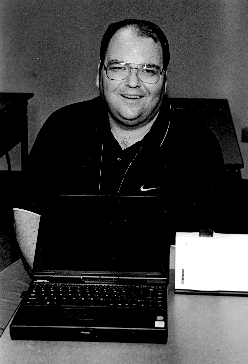|
|
Riding The New Wave Of NetworkingTechnology: The School of Hygiene and Public Health takes a wireless route to the Internet
Greg Rienzi
|

At the School of Hygiene and Public Health just being able to surf the Net wasn't enough. Nowadays, windsurfing is all the rage.
Promoting Internet access anytime, anywhere, the school has outfitted its buildings with NetWave transmitters that allow students and teachers with laptop computers to drive along the information superhighway without being connected to network wires.
The wireless networking program, which utilizes technology similar to that used by portable phones, was piloted in the spring of 1997. Its installation was intended to free up congestion in the school's three computer labs and to assist electronic learning. It was also seen as an alternative to the costly hard wiring of the school's 80-year-old main building.
 |
| Laptops and transmitters like these give students wireless access to the Internet. "Computers have become an extremely important tool for researching public health issues," says Ross McKenzie. |
The transmitters, called wireless access points, work by emitting radio waves with a range of 100 to 150 feet that can be picked up using a Netwave card, a kind of Internet antenna, which is inserted into the PC core slot of a laptop. These access points are connected to existing network wires and are installed in out-of-the-way locations such as the ceiling.
Students with these Netwave cards can now search the Internet, send and receive e-mail, or print a document from most locations in the school's buildings: in class, the cafeteria or even the student lounges.
Ross McKenzie, director of the School of Public Health's Information Systems, says this new wireless system was an ideal solution to the problem of students not being able to use the Internet or local network during certain times of the year. "It can get hectic around here when we're having midterms or finals, and students are scrambling to use the three computer labs," McKenzie says. "A huge part of having this system is that no longer are all our students forced to share 75 computers."
So far, McKenzie says, the wireless system has been extremely successful in reducing the traffic in the computer labs.
Most of the school was wired--or, as McKenzie likes to say, "un-wired"--last fall. Any student with a PC laptop (the system is not configured to work with Macintosh computers) can sign up to have a Netwave card, Web browser and networking software installed on his or her computer for free. The agreement requires that the user return the Netwave card undamaged at the end of the academic year.
The wireless access points have been installed in 40 classrooms, two cafeterias, two libraries, three lounges, six conference rooms and two auditoriums in the school's main building, Hampton House and the Candler Building downtown, and is planned for the Montgomery County Center. The cost of installing the system was $150,000, compared to the approximately $720,000 it would have cost to have hard wired all these locations.
"We thought that was a pretty significant savings," McKenzie says. "For older buildings this is certainly the way to go. But in a new building it's still better to have the wiring built in and just put it into construction cost."
Each access point can accommodate 15 users at any one time. Yet McKenzie says that since access points have a range of more than 150 feet, overlap occurs, and a 16th student who is trying to log on the Internet in a full classroom might be able to pick up the signal from the room above, below or to either side.
"We've been able to grid almost the whole building," McKenzie says.
The wireless system is part of the School of Hygiene and Public Health's Laptop Pilot project, a push for students to bring computers to class. Along with the wireless network, the school is offering a battery-exchange program; a $500 rebate to the first 200 students and discounts for others who purchase an IBM or Dell laptop through the school; and shipping service and the use of a loaner during warranted repairs.
"Computers have become an extremely important tool for researching public health issues. They're not just for word processing," McKenzie says, adding that the school is considering requiring students to have a laptop.
Students who are unable to attend a lecture can use the wireless system to connect to the course's Web site to access lecture notes, animated demos and Power Point demonstrations.
McKenzie says the only disadvantage of wireless Internet access is that it's limited to campus use, and students might encounter problems when downloading large files.
Yet, he adds, an upgrade scheduled for later this year will increase the access point's bandwidth and should improve the system's performance.
| GO TO JULY 20, 1998 TABLE OF CONTENTS. |
| GO TO THE GAZETTE HOMEPAGE. |